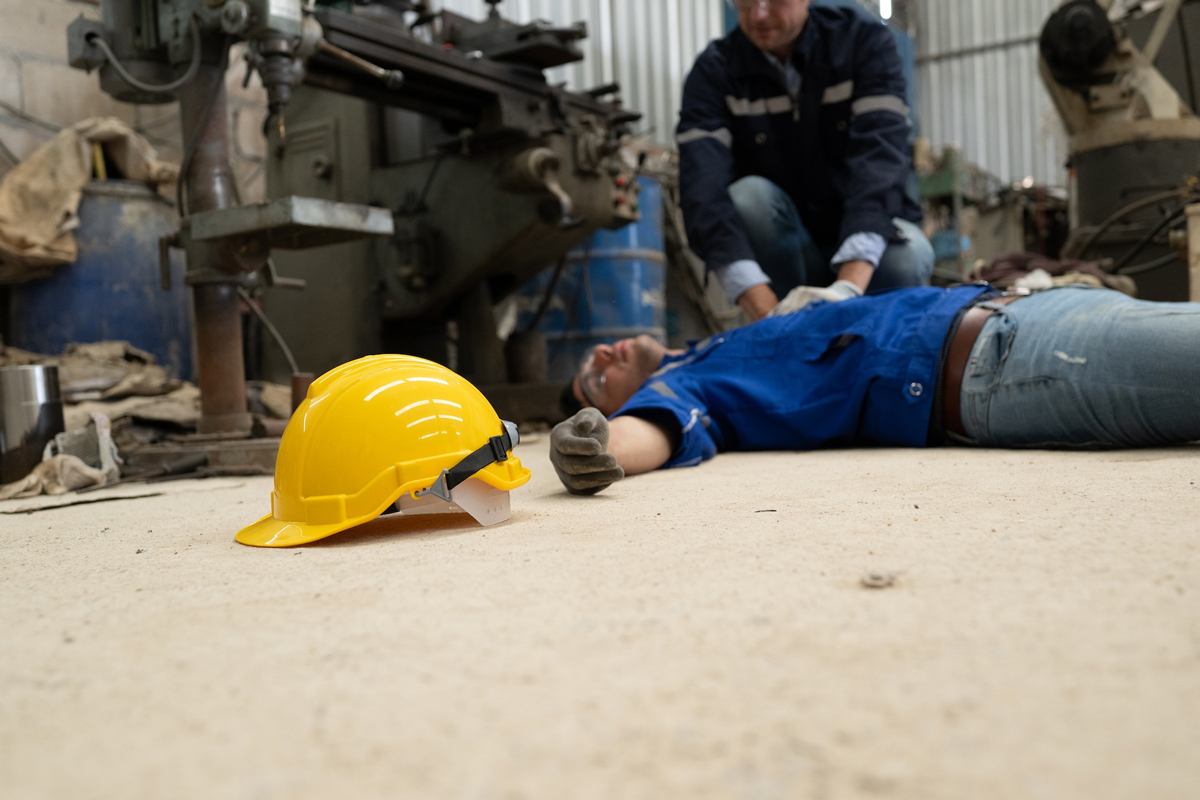
Top 10 Most Common Workplace Injuries
Every day, employees in various industries and professions are exposed to a range of hazards that can cause workplace injuries. Some of these injuries can be minor and easily treatable, while others are more severe and can have long-term consequences for the worker and their employer.
Common workplace injuries not only result in physical suffering but can also lead to financial losses for businesses due to medical expenses, lost productivity, and legal fees. It is crucial for employers and employees alike to understand the types of injuries that can occur on the job and take preventative measures to mitigate their risks.
Top 10 Workplace Injuries
1. Overexertion Injuries:
These are injuries caused by excessive physical effort, such as lifting heavy objects or repetitive tasks. Overexertion injuries account for nearly a third of all workplace injuries.
Overexertion injuries can affect any part of the body, though they are most commonly found in the back and shoulders due to strain and stress. They can range from minor muscle strains to severe spinal disc herniation. Common symptoms include pain, stiffness, fatigue, numbness, and weakness.
The primary cause of overexertion injuries is when workers lift or move objects that are too heavy for them or perform the same task over and over again. Other causes include poor posture, lack of warm-up before starting a job, and inadequate safety equipment.
2. Slips, Trips, and Falls:
Slips, trips, and falls are some of the most common workplace injuries. They often occur due to poor lighting, cluttered walkways, wet or slippery floors, uneven steps or stairs, and other hazardous conditions. Falling on the same level, falling to a lower level, and tripping on an object are all too common causes of workplace injuries

Falling on the same level can be caused by loose cords or wires on the floor, chairs or furniture that have been moved out of place, or objects left in walkways. Falling to a lower level can result from unguarded openings in the workplace, such as stairwells or pits. Tripping on objects can be caused by items left on the floor, loose rugs, or uneven surfaces.
Common symptoms of slips, trips and falls include bruises, cuts, scrapes, sprains, strains, and broken bones.
3. Struck by Object:
This type of injury occurs when a worker is hit by a falling object, such as loose debris or tools.
Struck by object injuries are one of the most common workplace injuries. This type of injury occurs when a worker is struck by a falling object, such as tools, machinery components, supplies or debris. When something falls from an elevated area and strikes a person at work, it can cause severe and even life-threatening injuries.

The most common struck by object injuries occur in construction sites where workers are exposed to falling objects, such as tools, from elevated heights. Other common causes of this type of injury include defective equipment, improper storage of materials, and lack of safety measures.
The most common symptoms of struck by object injuries include cuts, bruises, fractures, amputations, and concussions.
4. Injuries From Machinery:
Injuries from machinery are among the most common workplace injuries. These injuries are caused by operating or working near dangerous machinery, such as conveyor belts or forklifts. Such injuries can range from minor cuts and bruises to catastrophic accidents that may result in amputation or even death.
The Occupational Safety and Health Administration (OSHA) considers operating heavy machinery a serious hazard for workers and has established strict safety regulations to protect them. Common causes of these injuries include improper training, lack of protective equipment, inadequate machine maintenance, and failure to follow safety protocols.
5. Repetitive Motion Injuries:
These are injuries caused by performing repetitive tasks, such as typing or using a cash register, over an extended period. These types of injuries occur when muscles and tendons are used for an extended period in the same motions. Examples of repetitive motion activities include typing, using a cash register, lifting, carpal tunnel syndrome, assembling products, operating machinery, and using hand tools.
As with any injury, prevention is the best approach to avoiding these types of injuries.
6. Car Accidents:
Despite advances in safety technology, motor vehicle accidents remain one of the most common accident causes of workplace injuries. In 2015, transportation incidents were responsible for more than a quarter of all fatal on-the-job injuries, with roadway incidents accounting for another 14%.
Car accidents can range from minor fender benders to serious collisions that cause catastrophic injury and death. Common workplace car accident injuries and work-related motor vehicle accidents, including those involving transportation incidents and roadway incidents, can cause severe injuries to employees including whiplash, broken bones, concussions, internal injuries, and post-traumatic stress disorder (PTSD).
7. Electrical Shock Injuries:
Electrical shock injuries are one of the most common workplace injuries, with potentially serious and fatal consequences. These shocks occur when a worker comes into contact with live wires or faulty equipment, resulting in an electric current passing through the body. This can cause burns, paralysis, cardiac arrest, and even death if not immediately treated. In some cases, electrical shocks can also lead to long-term health effects, such as nerve damage or hearing loss.
8. Burns:
Burns can result from exposure to flames, hot surfaces, chemicals, and even radiation. Minor burns include scalding, or contact with hot surfaces or liquids, while a more severe burn may be caused by exposure to open flames or chemicals.
The most important measure to take when it comes to preventing workplace burns is proper training and safety precautions. Workers should be trained to recognize and avoid dangerous substances, as well as wear protective gear when necessary.
9. Cuts and Lacerations:
Cuts and lacerations are among the most common workplace injuries, particularly in industries that use sharp tools or equipment. These types of injuries can occur due to a variety of causes, such as contact with sharp objects, improperly protected machinery, careless handling of tools, and repetitive stress.
Cuts and lacerations can range from minor scrapes and scratches to deep gashes requiring stitches. To prevent these injuries, workers should be trained to use the right tools for the job and wear protective gear when necessary.
10. Workplace Violence:
Workplace violence is a growing and serious problem in many workplaces. Despite the fact that it can take many forms, such as physical assaults, verbal abuse, and threats of violence, workplace physical violence is often overlooked or ignored until it is too late. Unfortunately, this type of injury can have devastating effects on both the victims and their families.
Workplace violence generally refers to any type of violent act that is perpetrated by a colleague, customer, or third party. Common injuries include broken bones, lacerations, concussions, and post-traumatic stress disorder (PTSD). To prevent workplace violence from occurring in the first place, employers should create policies and procedures to protect workers and hold aggressors accountable.
Preventing workplace injuries is crucial for the well-being of employees and the financial health of businesses. By implementing safety procedures, providing safety violence training, and ensuring that workers have access to protective equipment, employers can reduce the risk of occupational injury and create a safer work environment for everyone.
Workplace Injury Statistics |
| Total of 5,190 fatal work injuries in 2021, up 8.9% from 2020. [1] |
| There were 5,190 fatal work injuries recorded in the United States in 2021, an 8.9-percent increase from 4,764 in 2020, the U.S. Bureau of Labor Statistics reported today. The fatal work injury rate was 3.6 fatalities per 100,000 full-time equivalent (FTE) workers, up from 3.4 per 100,000 Full-time equivalent workers in 2020 and up from the 2019 pre-pandemic rate of 3.5. These data are from the Census of Fatal Occupational Injuries (CFOI). |
| In the year 2021, employers recorded 2.6 million instances of injury and illness, which showed a decrease of 1.8% compared to the prior year. |
| A worker died every 101 minutes from a work-related injury in 2021. [2] |
| Workers in transportation and material moving occupations experienced a series high of 1,523 fatal work injuries in 2021 and represent the occupational group with the highest number of fatalities. This is an increase of 18.8 percent from 2020. |
| In 2021, workers between the ages of 45 and 54 suffered 1,087 workplace fatalities, a 13.9-percent increase from 2020. This age group accounted for just over one-fifth of the total of fatalities for the year (20.9 percent). |
| Health care and social assistance had the highest rate of workplace illnesses, at 115.9 per 10,000 full-time workers. [3] |
| The Occupational Safety and Health Administration (OSHA) reports that the construction industry contributes to around 20% of work-related fatalities in private industry in our country. |
| 22 million US workers get exposed to hazardous levels of workplace noise every year. This is especially true for workers in the construction, manufacturing, and mining sectors. [4] |
| Workplace injuries have significant financial implications for both small businesses and their employees. Serious, non-fatal workplace injuries now account for nearly 50 billion in U.S. workers compensation costs, according to the 2022 Liberty Mutual Workplace Safety Index that reflects 2019 data. [5] |
Take Action to Address Your Workplace Injury and Alleviate Your Suffering
Accidents can happen anywhere, and the workplace is no exception. If you’ve been injured while on the job, taking the proper steps is crucial to ensuring that you receive the compensation and care you need. In the State of Nevada, all employers are required to have workers’ compensation for all employees, including part-time and leased workers.
Seek immediate medical attention even if the injury doesn’t seem severe, it’s important to have it properly documented in case it worsens over time. In the event of a serious injury, call 911 or seek medical attention at the nearest emergency room. If the injury is less severe, your employer may have a specific medical provider that you should see for evaluation and treatment.
It’s important to report the injury to your employer as soon as possible. Failure to do so may result in denial of your workers’ compensation benefits. Make sure to provide your employer with all the details of the injury and the circumstances under which it occurred. This information will be necessary when filing your workers’ compensation claim.
To receive workers’ compensation benefits, you must file a claim with the Nevada Division of Industrial Relations, this claim must be filed within two years of the incident, and it should include all necessary medical documentation and an explanation of how the injury occurred. Be sure to follow up with your employer and the workers’ comp insurance company to ensure that they have received all necessary documentation.
It’s important to remember that it’s your employer’s responsibility to provide workers’ compensation benefits to their employees. Seek immediate medical attention, report the injury to your employer, and file a workers’ compensation claim to receive the care and compensation you’re entitled to.
Shook & Stone have been fighting for the rights of the injured and have over 25 Years of legal experience. We work on a contingency fee basis meaning there are no upfront costs. Pay Nothing, Unless We Win. Contact us today for a consultation.
Sources:
[1] Census of Fatal Occupational Injuries Summary, 2021 – 2021 A01 Results. (2022, December 16). https://www.bls.gov/news.release/cfoi.nr0.htm
[2] Smith, S., & posts by Sandy Smith →, V. A. (2023, January 12). Census of Fatal Occupational Injuries: One U.S. Worker Died Every 101 Minutes in 2021 | Intelex Blog. Intelex Blog. https://blog.intelex.com/2023/01/12/census-of-fatal-occupational-injuries-one-u-s-worker-died-every-101-minutes-in-2021/
[3] BLS: Nonfatal workplace injuries increased in 2021, but illnesses dropped significantly. (2022, November 9). BLS: Nonfatal Workplace Injuries Increased in 2021, but Illnesses Dropped Significantly | 2022-11-09 | Safety+Health. https://www.safetyandhealthmagazine.com/articles/23227-bls-nonfatal-workplace-injuries-increased-in-2021-but-illnesses-dropped-significantly
[4] Masterson, E. A. (2017, August 25). Hearing Impairment Among Noise-Exposed Workers — United States, 2003–2012 | MMWR. Hearing Impairment Among Noise-Exposed Workers — United States, 2003–2012 | MMWR. https://doi.org/10.15585/mmwr.mm6515a2
[5] (2023, May 30). Liberty Mutual Business Insurance – https://business.libertymutual.com/wp-content/uploads/2022/06/WSI-1000_2022.pdf
 Sunny
Sunny The Importance of Seeking Medical Attention After a Personal Injury Accident
The Importance of Seeking Medical Attention After a Personal Injury Accident 